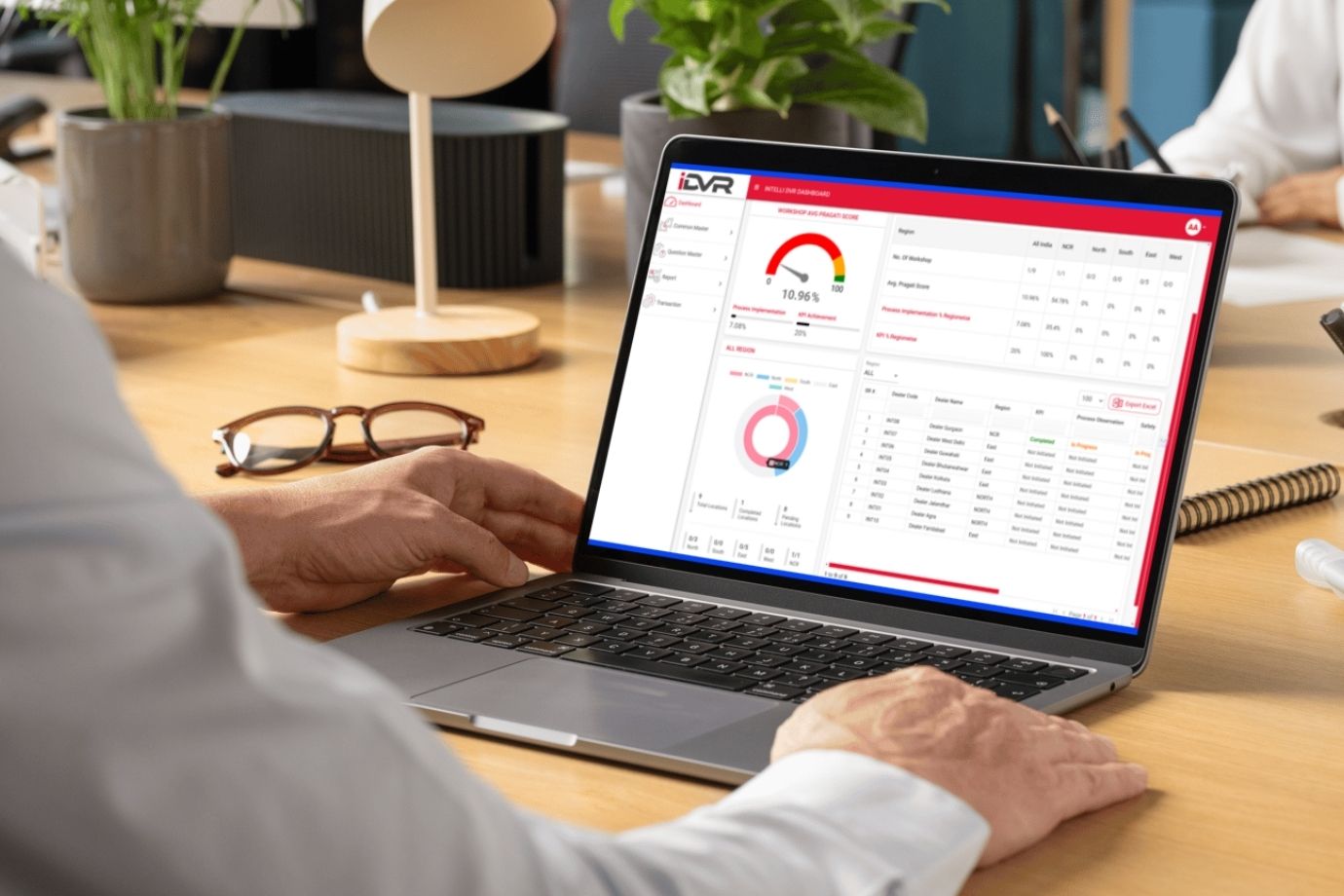
A strong dealership network allows OEMs to maintain brand standards and manage regulatory compliance. It helps them provide a consistent brand experience to their customers despite the dealership they walk into. Dealer audits help OEMs evaluate how well the dealers follow the brand guidelines. Regular and extensive audits enable OEMs to maintain brand reputation and identify areas of improvement.
Although it is necessary to comply with OEM standards, auditors and OEM managers may face several challenges during its execution. This article discusses how dealer audits ensure compliance and how they help in promoting the OEM’s brand ethics. We will also explore the challenges auditors face during audits and their practical solutions. Additionally, we shall discuss how advanced dealer audit software like Intelli DVR helps OEMs make audits more efficient.
Why Compliance with OEM Standards Matters

To have a consistent brand experience across the extensive dealer network, each dealership must follow the OEM-set guidelines. This helps in promoting trust and loyalty among customers.
When dealers comply with the brand guidelines, it ensures that the customer gets a consistent experience. Despite the location, customers always look for good service quality and availability of the product they require. This is why OEMs must ensure that all dealers adhere to the set guidelines, as it directly triggers customer satisfaction.
Compliance with OEM guidelines is also necessary for promoting competitiveness among dealers. A dealer with a better compliance score is more likely to meet customer expectations and reduce inefficiencies in service. This factor helps OEMs boost sales and build a robust brand reputation in the market.
Additionally, consistent adherence also helps in preventing possible legal risks and financial penalties. Regular dealer audits ensure that dealers align with necessary legal requirements and provide a stable business atmosphere.
Key Elements of Effective Dealer Audits

To conduct dealer audits effectively, OEMs should adopt a strategic approach where dealers align with brand standards and maintain service quality. The process often includes multiple elements, each of them contributing to successful audit outcomes. It also helps in promoting a positive relationship between OEMs and their dealer networks.
Dealer Visit Report
The dealer visit report is an inclusive document that records the findings of an audit. It is a crucial document that helps evaluate dealer performance in adherence with OEM-set guidelines.
A dealer visit report includes the following:
- Compliance Levels: This is a detailed assessment that indicates how closely the dealers adhere to the OEM’s standards.
- Identified Gaps: These are the particular areas that dealers should work on. These may include service shortcomings, non-compliance to brand standards, or poor operational efficiency.
- Practical Corrective Measures: The auditor may suggest certain actionable suggestions to help dealers improve performance and maintain compliance.
A well-curated dealer audit report encourages a balanced and practical narrative, helping dealers improve their service performance.
Best Practices for Dealer Audits
A successful dealer audit goes beyond merely identifying issues. It should promote a transparent and collaborative business environment. The significant practices for dealer audits include:
- Disclose Expectations Clearly: Auditors-in-charge must draft clear objectives and evaluation criteria for the audit before beginning the visit. It facilitates dealers to make essential preparations while ensuring a smoother audit experience.
- Constructive Feedback: Auditors should provide balanced and practical feedback instead of only focusing on the dealer’s pain points. Appreciating their achievements is equally important as it encourages dealers to adopt corrective measures readily and actively.
- Collaborative Approach: Regarding the audit as a partnership opportunity rather than an inspection encourages a positive and nurturing atmosphere. When dealers feel supported instead of investigated, they are more likely to accept recommendations offered during the audit.
- Efficient Follow-Ups: Regular follow-ups are essential to ensure that recommended improvements are thoroughly implemented. Regular conversations with OEMs provide them with necessary guidance, helping them actively maintain compliance.
These measures help OEMs ensure that dealers perceive audits as value-adding insights and not merely disciplinary actions.
Dealer Auditing Software
Technological advancements have mutated the dealer auditing process into a data-driven approach, increasing its accuracy and efficiency. Adopting dealer auditing software enables OEMs to streamline audit operations better.
This system allows OEMs to track data in real-time during the audit visit. It reduces the risk of errors or loss of crucial information that may surface. The captured data is then scanned to generate customized and detailed audit reports. This quick automated processing reduces time and effort while keeping manual errors at bay.
Additionally, the analytical features of dealer auditing software facilitate auditors to document their observations and findings dynamically. This enables OEMs to track compliance metrics consistently and ensure that dealers align to the brand standards at all times.
Implementing a strong dealer audit software enables OEMs to enhance audit efficiency and accuracy while ensuring compliance across the dealer network.
Benefits of Dealer Audits for OEMs and Dealers

Dealer audits are a powerful mechanism to ensure that dealership operations are well-oriented with the set OEM standards. If conducted effectively, dealer audits offer a wide range of benefits for both the OEMs and their dealer networks. Let’s have a glance at the primary advantages below:
Ensuring Adherence to OEM Guidelines
The primary objective of dealer audits is to ascertain that dealerships are operating in compliance with the quality standards set by the OEM. These specifications include a broad spectrum, such as service quality, branding, inventory management, operational procedures, and customer experiences.
By conducting regular dealership audits, OEMs can:
- Strengthen the importance of compliance to operational best practices.
- Identify instances where compliance may be crashing and offer targeted corrective measures.
- Ensure uniformity in customer experiences across all dealership locations.
This dynamic approach supports consistent service delivery and strengthens brand integrity.
Strengthening Brand Reputation
Dealerships must meet the OEM standards consistently to maintain a strong and positive brand image. Continuous adherence to OEM guidelines displays professionalism and is crucial for operational excellence. To develop brand trust and loyalty, customers must get a smooth, high-quality experience at every dealership. This not only enhances customer satisfaction but also provides OEMs with a competitive benefit in a highly dynamic market.
Identifying Training Needs
Audits are a critical medium for discovering areas where dealers may be lacking due to insufficient knowledge or training.
Commonly identified gaps in dealership operations are:
- Conflicting service delivery methods
- Misinterpretation of compliance requirements
- Incomplete or no familiarity with OEM policies or new technologies
Identifying these gaps helps OEMs in curating targeted training programs to address these specific challenges. It also enhances dealers' efficiency and helps them align with brand expectations.
Improving Collaboration and Communication
For OEMs to conduct dealer audits efficiently, it's crucial to maintain open and transparent relationships with the dealers. Here comes the need for a streamlined audit process that promotes transparency in communication. This approach also ensures that dealers have access to constructive feedback and grow mutually.
Essential factors of this collaboration include:
- Constructive communication: Instead of only stressing on shortcomings, auditors should provide a balanced feedback. This primarily includes highlighting their strength while also suggesting areas for improvement.
- Guidance and support: Audits are an opportunity for OEMs to suggest actionable and provide assistance to the dealers. This ensures that dealers have the required assistance to enhance compliance.
- Mutual accountability: Transparent audit processes encourage a culture of shared responsibility among dealers, promoting brand integrity.
This unified environment encourages dealerships to view audits as growth and improvement opportunities instead of burdensome initiatives.
Common Challenges in Dealer Network Compliance

While regular dealer audits are a necessary strategy for ensuring service consistency, OEMs may face challenges in maintaining compliance across a wide dealer network. Let’s discuss these common challenges in detail below:
Common Compliance Issues
Dealers usually face challenges in adhering to brand guidelines, resulting in poor compliance.
- Service Quality: When the dealer network is wide, it's difficult for OEMs to ensure all the dealerships provide a uniform service quality. Several irregularities and gaps in staff skills, service processes, and customer interactions may result in inconsistent customer experience.
- Inventory Demands: Another common challenge dealerships face is maintaining optimal inventory guidelines, including stocking the correct product and meeting its demand. Fluctuating market demands and limited storage space may cause dealers to struggle in regulating inventory continuously.
- Standardized Operations: Dealerships might find it challenging to implement formal operational processes and maintain them in the long run. Multiple factors may contribute to this inefficiency, including limited resources, lack of awareness, or inclination toward localized practices.
Additionally, when OEMs do not implement strong compliance guidelines, dealerships may find an opportunity to compromise operational efficiency. This may result in poor brand reputation while declining sales.
Communication Gaps
Transparent conversations among the dealers and OEMs are essential to build a compliance culture. However, maintaining clear two-way communication is a significant challenge when maintaining dealer network compliance.
- Impartial Expectations: Dealers might misunderstand the requirements when OEMs fail to communicate their expectations clearly. It not only strains the relationship between dealer and OEM but also negatively affects operational efficiency.
- Lack of Support: Dealers may get confused if OEMs are unable to provide enough support and practical guidance. It results in inefficient processing of compliance requirements, hampering service quality.
- Delays in Feedback: Irregular communication and delays in feedback increase downtime, complicating compliance even further.
Limited Training Programs
To get maximum benefits from the audits, its necessary that OEMs execute effective training programs. Poorly strategized training programs or those with insufficient knowledge often leave dealers confused, making them incapable of adhering to OEM guidelines.
- Knowledge Gaps: Without proper training, the dealership staff significantly lacks the required technical knowledge. This hampers the operational expertise needed to comply with OEM standards, affecting service quality.
- Inconsistent Execution: When all the team members do not receive training simultaneously, it may result in conflicts in process implementation. It also impairs the compliance efforts.
- Staff Resistance: Without training that intensifies the value of compliance, the dealership may be reluctant to adopt new processes or technologies introduced by the OEM.
This, in turn, makes it crucial for OEMs to structure effective training programs that are comprehensive, consistent, and focused on the specific needs of each dealership.
Strategies for Addressing Compliance Challenges

To overcome challenges and ensure compliance throughout the dealer network, OEMs should do more than draft guidelines. For dealers to feel valued, it's important that the OEMs promote a culture of continuous learning and provide them unconditional support throughout.
Below is a list of strategies to encourage dealers to overcome compliance resistance:
- Conduct Regular Audits: Regular audits enable OEMs to evaluate dealer performance while ensuring that compliance gaps are identified early. This also promotes a feedback culture and initiates two-way communication between OEMs and the dealerships.
- Communicate Openly: It’s necessary for the OEM to maintain transparent communication with the dealerships. It not only promotes a collaborative relationship but also encourages dealers to adhere to the brand guidelines. This also ensures that dealers understand compliance clearly, get quick responses to support, and initiate regular follow-ups.
- Execute Targeted Training Programs: OEMs should develop and implement focused training programs to ensure that the dealership staff is well-equipped with knowledge and skills. These programs may include hands-on workshops, e-learning modules, and certification courses.
The Role of Technology in Dealer Auditing

When OEMs implement advanced technology for dealer auditing, it simplifies this complex process and enables them to make data-driven decisions.
Let’s understand how technological implementation in dealer auditing improves the process efficiency:
Automated Data Collection
The traditional process of data collection often involved manual entry, frequently leading to inaccurate and inconsistent reports. Automating this process reduces human errors, enabling OEMs to generate uniform audit reports consistently.
Implementing the latest software further allows auditors to enter data through mobile devices. This enables them to input data even at any remote location and create consistent records with accuracy. Automation like this saves time while letting auditors focus on more important tasks.
Real-Time Data Updates
One of the most important features of technology in dealer audits is its ability to generate reports in real-time. Traditional methods often took hours and sometimes days to report, causing significant delays. On the other side, modern software overcomes manual processing, providing immediate results.
This quick processing allied OEMs and dealers to identify issues with non-compliance and take necessary corrective measures. It also promotes open conversations and transparency that strengthen relationships between stakeholders. Cloud-based solutions further facilitate remote access to data, making data sharing effortless.
Data-Driven Decision Making
Dealer auditing technology enables OEMs to make data-driven decisions, providing a complete overview of the auditing process. This helps OEMs to identify patterns, evaluate risks, and draft targeted strategies for improvement. This helps in detecting even those patterns that usually go unnoticed during manual processing.
Furthermore, such a data-driven approach enables OEMs to target areas with higher impact and ensure resources are allotted effectively.
Intelli DVR for Streamlined Dealer Audits

Intelli DVR is a comprehensive dealer auditing tool that helps OEMs streamline their dealer audit processes with high accuracy. When handling frontline tasks, technicians can use the system-integrated mobile application. It also comes with a web application allowing technicians to switch when managing background operations.
This dual-platform approach enables auditors to easily capture data in real-time and manage dealer audits. Intelli DVR’s intuitive interface makes it an ideal choice for OEMs willing to enhance their dealer audit operations.
Features of Intelli DVR that Improve Dealer Compliance
Intelli DVR provides robust features that enable field technicians to perform dealer audits easily and efficiently.
The significant features offered by Intelli DVR for enhancing dealer compliance include:
- Auditor Management: This feature allows OEMs to build their team of auditors effortlessly. With Intelli DVR, OEMs can curate a dealership master list and assign tasks to various auditors based on their skills and priority order.
- Data-Driven Insights: Analysis of resolution data provides valuable insights, enabling dealers to make informed decisions. It also facilitates transparency into dealer performance, preparing a culture of continuous improvement.
- Streamlined Re-Auditing: Intelli DVR integrates layouts such as Excel, PDF, and SSRs, providing a versatile reporting format. This allows dealers to present data in multiple ways and streamline data analysis.
- Create Checklists: Our software provides an intuitive feature that allows dealers to create checklists seamlessly. OEMs can standardize these checklists across all the dealers to enable a consistent auditing process.
- Backed with multiple question types: Intelli DVR supports multiple question formats, including simple text, single or multiple selection, and score-based questions. This helps to cater to the diverse needs of OEMs across industries.
Conclusion
Dealer audits are a crucial necessity of aftermarket operations that help OEMs ensure their dealerships comply with the brand guidelines. It not only strengthens the OEM-dealer relationship but also promotes two-way communication. This helps OEMs in identifying improvement areas early and strategizing corrective measures.
Modern software such as Intelli DVR streamlines these data audits and helps in improving dealer compliance. Streamlining tasks such as auditor management and multiple answer types.
Dealer audits help OEMs ensure that dealers adhere to brand guidelines and build a strong relationship with their dealer network. Effective dealer audits not only promote two-way communication but also help curate corrective measures such as training programs.
Modern technological advancements like Intelli DVR allow OEMs to ease dealer audits and improve compliance monitoring. It is crucial for building a strong, compliant, and efficient dealer network.
To learn more about how Intelli DVR can streamline your dealer audits or request a free demo, connect with us today.
Explore More Insights
About the Author
Chandra Shekhar
Chandra Shekhar is the Senior Manager, Strategy & Business Development at Intellinet Systems. With over a decade of experience in the automotive industry, Chandra Shekhar has led digital transformation and aftersales strategy initiatives for OEMs across multiple markets. His background combines deep industry knowledge with a practical understanding of how technology can solve real operational challenges. He focuses on making complex ideas clear and relevant for automotive and aftermarket professionals navigating ongoing change.



























